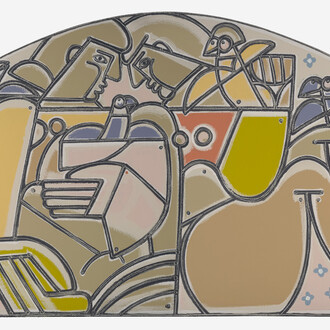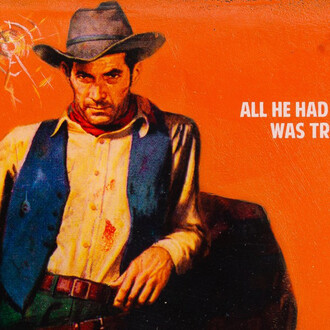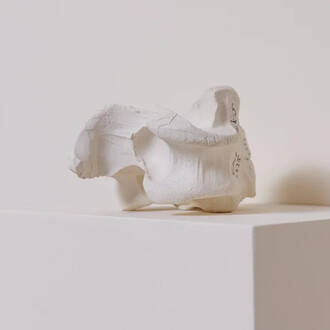What does it mean to be delivered? One may be delivered by a god, delivered by a mother. It seems to entail a springing forth from nothing—as Athena did from Zeus’ head—but the delivery in childbirth happens at the end of pregnancy, not the beginning, an emergence that occurs after forty long weeks of gestation, the mother, delivered too—from pregnancy—in the process.
In her solo show Deliverance, Moll Brau exhibits work related to the gestation and birth of her daughter, showing images that came to her during her first pregnancy. The visions and imagined landscapes evoke Brau’s feelings of transition, liberation, dread, and salvation.
In 1969, as part of her Maintenance Art Manifesto, Mierle Laderman Ukeles wrote, “I am an artist. I am a woman. I am a wife. I am a mother (random order)”. In 1968, in the performance Mon fils, Lea Lublin displayed her son—and her work as a mother—as her art. This is not to essentialize the work of mother artists, but rather to ask, critically: What is the difference between growing a life and growing an artwork? An abundance of pain, sweat, tears, no doubt. But do artists not deliver—both an artwork to an audience and an audience to an artwork? Or an audience from the tedium of life otherwise?
In Mid-air and Gyre (both 2024), Brau continues her tradition of auto-figurative work, but now, body parts stand in synecdochically for the body as a whole, otherwise elided. In Mid-air, two disembodied hands hold the ropes of a swing; two pathways, marked in a field—I imagine desire paths, put there not by planner’s intervention, but by the treading of those who wish to get to the swing—span where the legs would be, kicking out as they pump, pump, pump away. Body slides into environment; environment slides into body. It is a reminder that we come from Mother Earth, and to Mother Earth we shall return.
In Gyre, two disembodied feet stand in the foreground; in the background, a trap door, open—to where does it lead? Beside it, an eagle breaks its chains. We see it the moment before it flies into the great unknown, a moment of stasis before frenzied motion, the beating of wings. The unknown brings us back to the feet: Where is the rest of the body? The viewer is left with a feeling of unease, as much as they feel hope—to not know leaves one open to anything, be that good or bad. In anyone’s life, at any time, deliverance can be experienced as a plot twist, a trap. But—what if it is a trapdoor to a better reality just waiting for your arrival?
In Home base (2024), we see a similar ambivalence: a tarantula, seemingly resting, on a pregnant figure’s belly. While such a creature may traditionally evoke fear, instead, we find similitude: knitting needles, resting on the figure’s breast, connect her to the web-weaver, who spins her thread to prepare for a brood of her own.
A reservoir for dreams, Cherubic dawn, and Her crucible (all 2024) place us within dreamlike environments. A reservoir for dreams comprises a lagoon; surrounding it, eggs as flowers, emerging from the ground. What grows here? In what—and in whom—do we place our dreams? In Cherubic dawn, a day breaks, a golden sky the sign. Barely visible within the reddish cloud are fecund torsos, a whisper of hands, of heads. It is primordial; like a butterfly emerging from the soup of its chrysalis, a child will be born. The title of Her crucible brings a shadow to the painting, its figures otherwise calm, still. Their stillness places them at odds with the tide pool surrounding them—is this pool their crucible? Will they emerge unchanged?
Gyre: a spiral form, a tide pool. Yeats: “Turning and turning in the widening gyre / The falcon cannot hear the falconer; / Things fall apart; the center cannot hold”. From the Greek, gyros, it’s hauntingly similar to gynē, woman, the root for gynecology. The moment of birth: the falcon cannot hear the falconer. Until—a cry, a baby born, and a mother laughs in relief.
What does it mean to be delivered? For the artist, it seems to carry uncertainty. But it is, perhaps, in the end, to be saved.
Moll Brau is a multi-disciplinary artist from Shreveport, Louisiana with practices in painting, video work, performance, and installation. This is her second solo exhibition with the gallery as well as a solo booth at Expo Chicago. Other notable exhibitions include a solo at 12.26 Dallas and Rusha & Co in Los Angeles, as well as group shows with Inman Gallery in Houston and Half Gallery in New York.
(Text by Grace Sparapani)









![Pierre-Alexandre Aveline, L’enseigne de Gersaint [Gersaint’s shopsign], 1732. Courtesy of Blanton Museum](http://media.meer.com/attachments/c5370da82bda65bbf2a5ffb19cb78ae64984c3aa/store/fill/330/330/266ac860d2c6aeb404ddd64b2c2db1048cf20b581337c6a38146d5cc4ce5/Pierre-Alexandre-Aveline-Lenseigne-de-Gersaint-Gersaints-shopsign-1732-Courtesy-of-Blanton.jpg)



